Anton Raphael Mengs
Anton Raphael Mengs (22 March 1728[1] – 29 June 1779) was a German (Saxon) painter, active in Dresden, Rome and Madrid, who while painting in the Rococo period of the mid-18th century became one of the precursors to Neoclassical painting, which replaced Rococo as the dominant painting style.
Anton Raphael Mengs | |
|---|---|
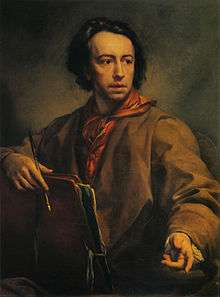 Self-portrait, c. 1775. | |
| Born | 12 March 1728 |
| Died | 29 June 1779 (aged 51) |
| Nationality | German |
| Occupation | Painter |
| Movement | Neoclassical |
| Spouse(s) | Margarita Guazzi (m. 1748) |
| Children | Anna Maria Mengs |
| Relatives | Therese Mengs (sister) Julia Charlotte Mengs (sister) |
Early life
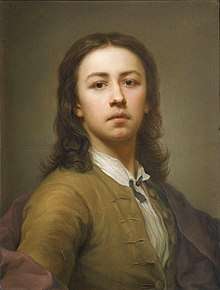
Mengs was born in 1728 at Ústí nad Labem (German: Aussig) in the Kingdom of Bohemia, the son of Ismael Mengs, a Danish painter who eventually established himself at Dresden, where the court of Saxonian-Polish electors and kings was. His older sister, Therese Maron, was also a painter, as was his younger sister, Julia.
His and Therese's births in Bohemia were mere coincidence. Their mother was not their father's wife; Ismael carried on a years-long affair with the family's housekeeper, Charlotte Bormann. In an effort to conceal the births of two illegitimate children, Ismael took Charlotte, under the pretext of "vacations", to the nearest bigger town abroad, Ústí nad Labem (90 km upstream of the Elbe River). At least in Anton's case, Ismael Mengs took his baby and Charlotte back to Dresden a few weeks after the birth. There they lived for the next 13 years.[2]
In 1741 Ismael moved his family from Dresden to Rome.
Adulthood and death
In 1749 Anton Raphael Mengs was appointed first painter to Frederick Augustus, elector of Saxony, but this did not prevent him from continuing to spend much of his time in Rome. There he married Margarita Guazzi, who had sat for him as a model in 1748. He converted to Catholicism, and in 1754 he became director of the Vatican painting school.[3] His fresco painting Parnassus at Villa Albani gained him a reputation as a master painter.
In 1749 Mengs accepted a commission from the Duke of Northumberland to make a copy, in oil on canvas, of Raphael's fresco The School of Athens for his London home. Executed in 1752–5, Mengs's painting is full-sized, but he adapted the composition to a rectangular format and added other figures. It is now in the collection of the Victoria and Albert Museum.[4]
Mengs died in Rome in June 1779 and was buried there in the Church of Santi Michele e Magno.
Career
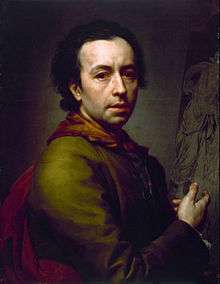
On two occasions he accepted invitations from Charles III of Spain to go to Madrid. There he produced some of his best work, most notably the ceiling of the banqueting hall of the Royal Palace of Madrid, the subject of which was the Triumph of Trajan and the Temple of Glory. After the completion of this work in 1777, Mengs returned to Rome, where he died two years later, in poor circumstances, leaving twenty children, seven of whom were pensioned by the king of Spain.[5] His portraits and self-portraits recall an attention to detail and insight often lost in his grander paintings.
His closeness to Johann Joachim Winckelmann[6] has enhanced his historical importance. Mengs came to share Winckelmann's enthusiasm for classical antiquity, and worked to establish the dominance of Neoclassical painting over the then popular Rococo style. At the same time, however, the influence of the Roman Baroque remained strong in his work, particularly in his religious paintings. He would have fancied himself the first neoclassicist, while in fact he may be the last flicker of Baroque art. Rudolf Wittkower wrote: "In the last analysis, he is as much an end as a beginning".[7] Goethe regretted that "so much learning should have been allied to a total want of initiative and poverty of invention, and embodied with a strained and artificial mannerism."[8]

Mengs had a well-known rivalry with the contemporary Italian painter Pompeo Batoni. He was also a friend of Giacomo Casanova. Casanova provides accounts of his personality and contemporary reputation through anecdotes in his Histoire de Ma Vie. Among his pupils in Italy were Anton von Maron, Antonio Maron (Vienna, 1731- Naples 1761).[9] His pupils in Spain included Agustín Esteve.
Besides numerous paintings in Madrid, the Ascension and St Joseph at Dresden, Perseus and Andromeda at Saint Petersburg, and the ceiling of the Villa Albani are among his chief works.[5] A Noli me tangere was commissioned as an altar-piece by All Souls College, Oxford, and is now held in the National Gallery, London.[10] Another altar-piece was installed in Magdalen College, Oxford.[3]
Theoretical writings
Mengs wrote about art in Spanish, Italian, and German. He reveals an eclectic theory of art that sees perfection as attainable through a well-balanced fusion of diverse excellences: Greek design combined with the expression of Raphael, the chiaroscuro of Correggio, and the colour of Titian.[5]
Selected works
- Ascension (Dresden, Court Church), 1751/1766
- St Joseph (Dresden, Court Church), 1751/1766
- The Glory of Saint Eusebius (ceiling fresco, Sant'Eusebio, Rome), 1757 (modello, oil on canvas, National Gallery of Canada Ottawa)
- Portrait of Ferdinand I (National Museum of Capodimonte, Naples, Italy), 1759
- Charles III (Museo del Prado, Madrid), 1761
- Infante Don Louis de Borbon (Cleveland Museum of Art, Cleveland, Ohio)
Gallery
_-_02.jpg) Prince of Asturias, Future Charles IV of Spain (са 1765)
Prince of Asturias, Future Charles IV of Spain (са 1765)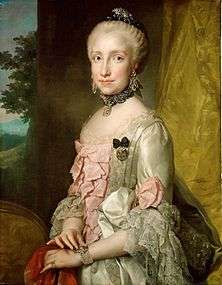 Portrait of Maria Luisa of Spain
Portrait of Maria Luisa of Spain Helios as Personification of Midday (ca. 1765)
Helios as Personification of Midday (ca. 1765)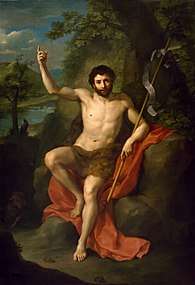 St. John the Baptist Preaching in the Wilderness
St. John the Baptist Preaching in the Wilderness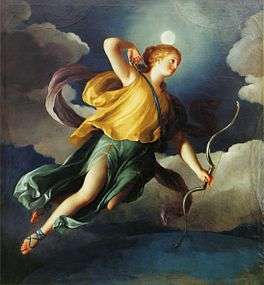 Diana as Personification of the Night (ca. 1765)
Diana as Personification of the Night (ca. 1765) La marquesa de Llano
La marquesa de Llano Madonna and Child
Madonna and Child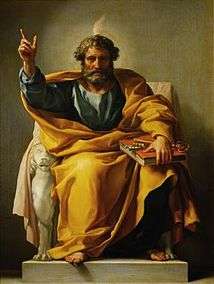
%2C_ceiling_fresco_in_the_Camera_dei_Papiri%2C_Vatican_Library%2C_1772_-_M0tty.jpg) The Triumph of History over Time, ceiling Vatican Library.
The Triumph of History over Time, ceiling Vatican Library.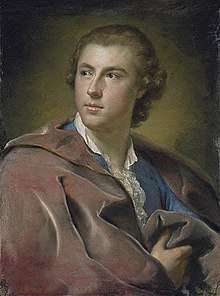 Portrait of William Burton Conyngham (1733–1796)
Portrait of William Burton Conyngham (1733–1796)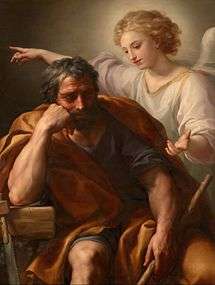 The Dream of St. Joseph, 1774
The Dream of St. Joseph, 1774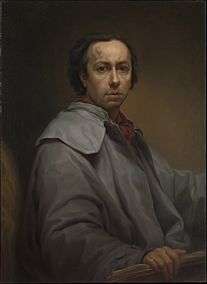 Self Portrait at the Metropolitan Museum of Art, 1774
Self Portrait at the Metropolitan Museum of Art, 1774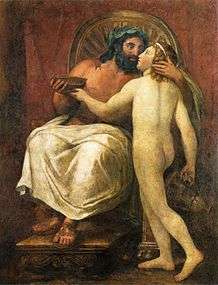 The notorious fake antique fresco of Jupiter and Ganymede, tailored to deceive Winckelmann has been attributed to Mengs or Giovanni Casanova[11]
The notorious fake antique fresco of Jupiter and Ganymede, tailored to deceive Winckelmann has been attributed to Mengs or Giovanni Casanova[11].jpg) Johann Joachim Winckelmann (1717–1768) at the Metropolitan Museum of Art, 1777
Johann Joachim Winckelmann (1717–1768) at the Metropolitan Museum of Art, 1777 Seated Nude Male at the Metropolitan Museum of Art
Seated Nude Male at the Metropolitan Museum of Art
See also
- Karl Woermann, Ismael und Raphael Mengs (Leipzig, 1893)
Notes
- "Anton Raphael Mengs (Bohemian painter)". Encyclopædia Britannica. Retrieved 30 March 2012.
- Polt, John H. R. (1997). "Anton Raphael Mengs in Spanish Literature". In Font, Jordi Aladró (ed.). Homenaje a Don Luis Monguió. Hispanic monographs: Series Homenajes 13. Newark, DE: Juan de la Cuesta. pp. 351–374. ISBN 978-0-936388-82-3.
- Chisholm 1911.
- "The School of Athens (after Raphael)". Victoria and Albert Museum. Retrieved 3 July 2014.
-

- "Web Gallery of Art, image collection, virtual museum, searchable database of European fine arts (1000–1900)". wga.hu.
- Wittkower, p 469
- Johann Wolfgang von Goethe, Winckelmann und sein Jahrhundert
- Supplemento alla Serie dei trecento elogi e ritratti degli uomini i più illustri in Pittura, Scultura, e Architettura. by Pellegrino Antonio Orlandi, published by Stamperia Allegrini, Pisoni, e comp, Florence (1776); column 1368–1369.
- "Noli me tangere". The National Gallery. The National Gallery. Retrieved 21 July 2018.
- A case for an attribution to Giovanni Casanova, brother of the famous memoirist and rake, was made by Thomas Pelzel, "Winckelmann, Mengs and Casanova: A Reappraisal of a Famous Eighteenth-Century Forgery", The Art Bulletin 54.3 (September 1972:300-315).
Sources
- Wittkower, Rudolf (1993). "Art and Architecture Italy, 1600–1750". Pelican History of Art. 1980. Penguin Books Ltd. p. 469.
- Herbermann, Charles, ed. (1913). . Catholic Encyclopedia. New York: Robert Appleton Company.
- Neil Jeffares, Dictionary of pastellists before 1800, online edition
- Paintings by Anton Raphael Mengs at WikiGallery.org
External links
| Wikimedia Commons has media related to Anton Raphael Mengs. |
- Europe in the age of enlightenment and revolution, a catalog from The Metropolitan Museum of Art Libraries (fully available online as PDF), which contains material on Mengs (see index)
- 'Self-portrait' (1774) at the Walker Art Gallery, Liverpool
- 'Portrait of Charles III' (1761) at the Museo del Prado
- . New International Encyclopedia. 1905.